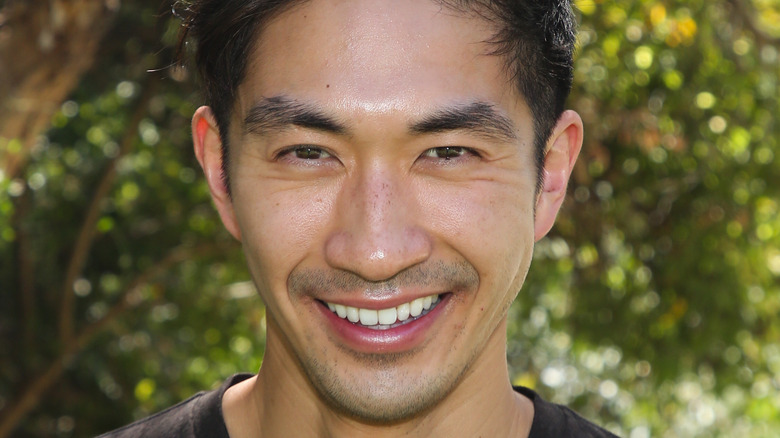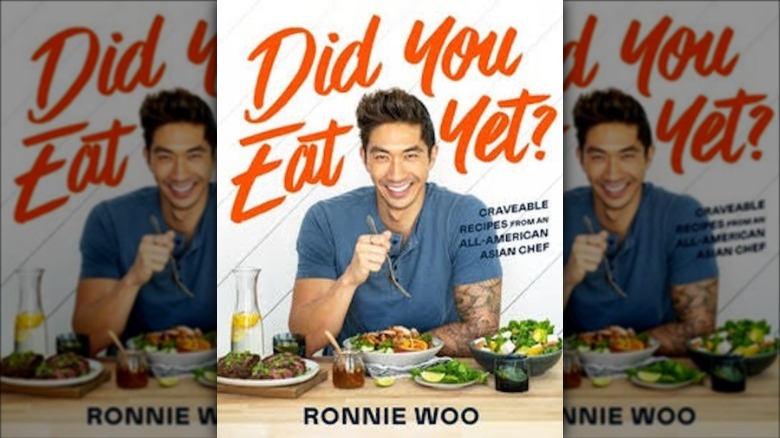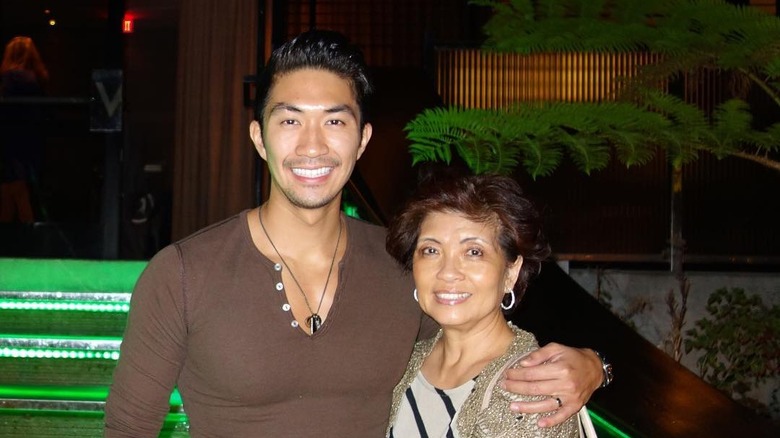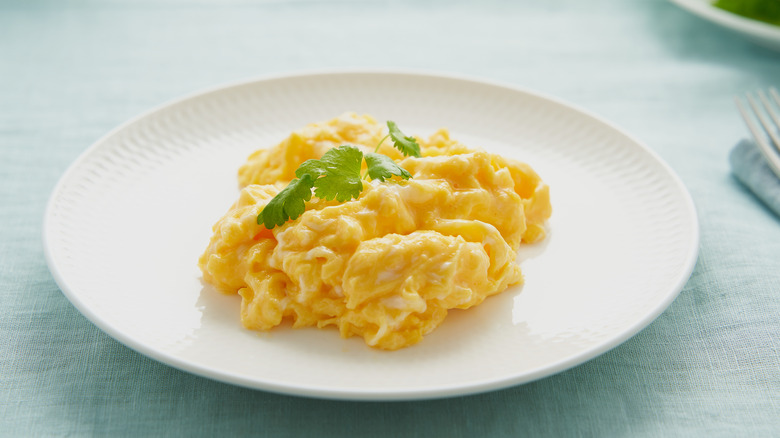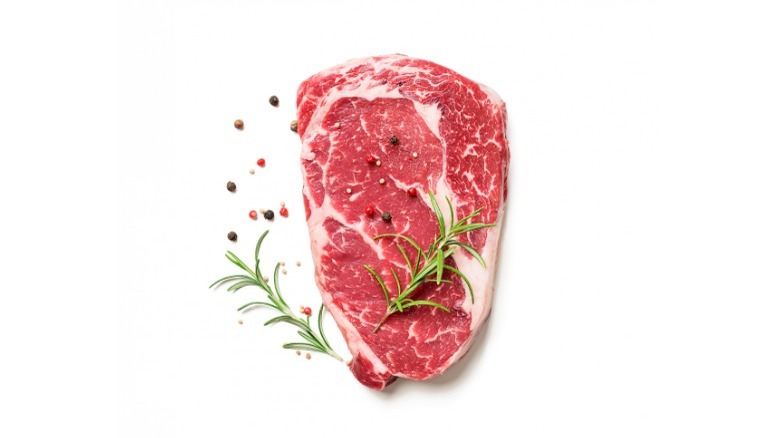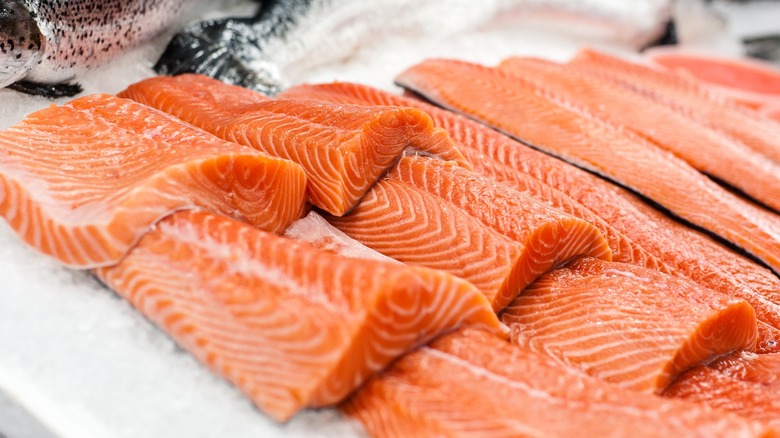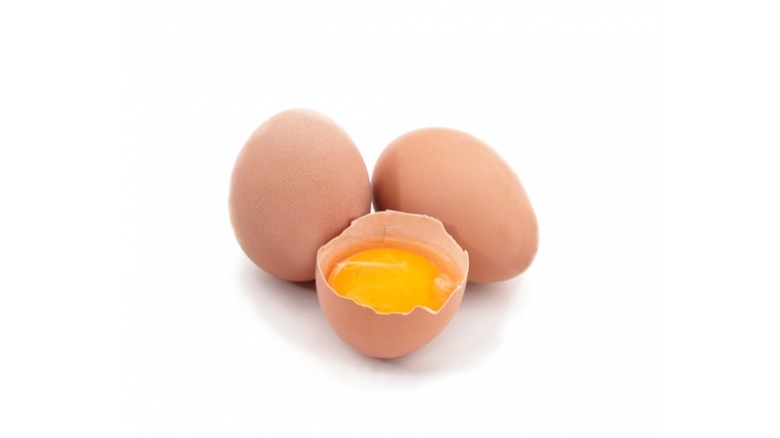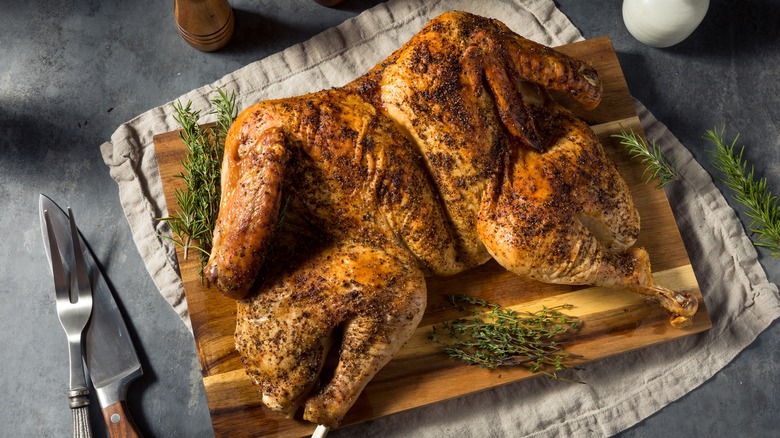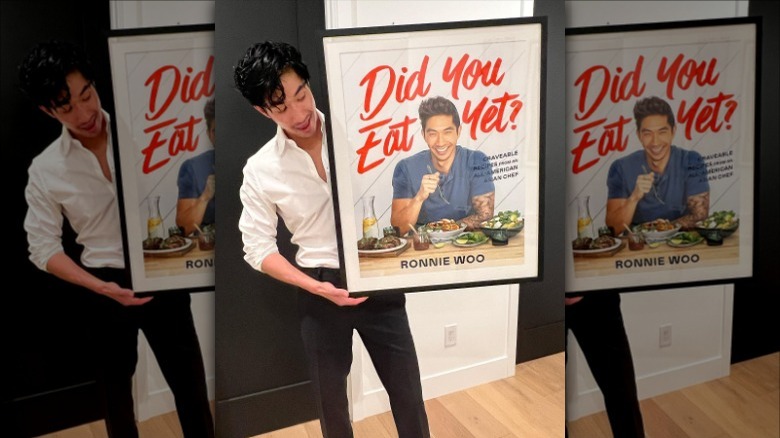Ronnie Woo Embraces Breaking The Mold With New Cookbook Did You Eat Yet - Exclusive Interview
Ronnie Woo has worn many hats in his life. As a model turned therapist turned chef, he brings a wide array of skills and experiences to his cooking career. He has spent time both as a private chef and the host of the television show "Food to Get You Laid."
Now, Woo is bringing his signature lighthearted, cheeky tone to his new cookbook, "Did You Eat Yet?" Alongside pictures of his three beloved pups — Taco, Queso, and Unagi — the book features a wide array of recipes that pull from different flavors and styles. With chapter titles such as "Breakfast All Day, Err' Day" and "I Love Noods," readers and home cooks are sure to smile their way through his recipes. The book is easily approachable for new cooks, while still providing new and interesting tastes and techniques for seasoned pros.
We met up with Woo for an exclusive interview to discuss his new book, and he also gave us even more tips that will lead to culinary conquests.
Becoming a chef
You started as a model, then became a therapist — now you're a chef. How and why did you make those leaps, and do you find any of the skills from your prior careers have transferred to being a chef?
There's no real rhyme or reason as to how I made the leap, to be totally honest. When I was younger, I wanted representation. It's funny — in the modeling world, back then ... Now, it's a lot better. But back then, it was like every agency had one Asian model, and if they already had an Asian model, I would hear the same old thing, which was, "We already have an Asian model." No joke. I'm like, "But we look nothing alike" ...
I moved to LA [and] became a model. After a year or two, I wanted to go back to school. I went back to UCLA. I got my undergrad, and then I actually got two master's degrees: one in marriage and family therapy, and an MBA. I wanted to help people in their relationships ... but [I realized] that, as a therapist, I don't think I would be as helpful as I would want it to be, simply because of my personality.
After having done both master's degrees, I was like, "Well, what do I really want to do? What brings me a lot of joy?" Ultimately, I was like, "If I could choose any career that I wanted to do, I would do something in food." Growing up in an Asian American family, it's either you're a doctor or a lawyer — the stereotype is very true. It was very much, for the longest time, I could either be a doctor or a lawyer ...
I live this way where if I want to do something, I do it. I start that very day because I don't want to live a life of regret. I feel like if nothing's holding you back, there's no reason [not] to start now. I basically locked myself in my kitchen for six months and taught myself how to cook, and then started a private chef company called The Delicious Cook. Shortly after that, I got my first television show. The rest is history.
International influences
What does it mean to you to be an "all-American Asian chef"?
You can either say all-American Asian chef, [or] some people say Asian American. The reason why I say all-American Asian chef is because I identify as all-American, but I also identify as all-Asian. For the longest time, with identity crises — especially the up-and-coming generations — it's like we're all a mix, different backgrounds and ethnicities and things.
When I was growing up, it was like, "Well, am I American, or am I Asian?" At some point, I was like, "I don't need to be one or the other. I can be all of them and still be my authentic self. It doesn't need to be a choice."
Your recipes pull from a wide range of backgrounds and flavors. What are some of your biggest food influences?
My biggest influences would be my mom and my grandmother, probably because I grew up eating my mom's food the most. We didn't necessarily have one specific restaurant or chef that we always visited or whose restaurant we went to. We love everything. Our whole family loves everything.
The food that I ate the most was my mom's and then my grandmother's. [They were] probably the biggest influence as far as the way that I make food and the way that I prepare food, but a lot of inspiration and influences come from all over the place, whether it's a restaurant that I've been to or a lot of my travels and seeing the world.
One of the things I love about your book is its charm and approachability. For people who may be new to cooking or finding your book for the first time, what is one of your favorite simple weeknight recipes?
There's so many, and it depends on what your MO is ... One vegetarian [dish] would be the spicy almond pesto with burrata. It's made with udon. It's hardy and super flavorful and delicious and light, but decadent at the same time. It's easy, and you can add certain things to it as well.
If you do eat meat, I love my Bulgogi pork tenderloin lettuce wraps, because that's also light but satisfying. We do this bibimbap-inspired sauce, and it's super satisfying. It's a mouthful, and you eat it with your hands and it's really fun. Those are the two that if I had to be like, "Start with these two and then work your way around the book," [it'd be those].
Perfect eggs
In your book, you have the recipe for the cheesy chili oil egg sandwich, and you give very specific directions on making the eggs. What is the trick to getting those perfectly cooked, non-rubbery eggs?
I'm very specific about it because this dish is super simple, but it is also one of my favorite breakfast dishes. Since you mentioned it, this would also make a great quick weeknight dish too, because you can have [breakfast] any time of day.
This one is actually one of my favorite recipes out of the entire book ... I'm specific because the key to making non-rubbery eggs is cooking them on low heat. [If] you cook them on high heat, they turn rubbery and dry and weird — a weird texture. But if you cook them on low heat and you're a little bit more patient ... It doesn't even take 30 minutes more. It's maybe 5, 10 minutes more, but it makes all the difference.
In this recipe, it's pretty simple. It's eggs and a little bit of cheese, and that's all that's in the actual egg mixture. Then you swirl it around the pan and make sure you're taking a spatula and moving the eggs constantly so the eggs are never constantly touching the pan for too long. That's the key. You keep swirling until you get these luxurious, yummy, smooth eggs.
Steak preferences
You wrote, "I rarely ever judge people, but when I do, it's because of how they like their steak." What is the biggest faux pas that people commit when preparing their steaks?
I don't want to call anyone out here — one of my clients is this well-known comedian, and I won't list her. She likes her steak like ... I remember her asking me to take this gorgeous piece of filet mignon and chop it up into tiny little pieces and cook it until it's gray.
I was like, "What is happening? I'm not sure if I can morally do that. Like, ethically, that's wrong." I was like, "This poor cow died and I'm going to turn it into jerky." I don't want to judge you, but I'll judge you if your steak [is] super-duper well done ...
I don't want to turn anyone off if they're like, "I like steak well done — he's so judgy with how he likes his steak." [It] is more so how I judge a restaurant. It's more like when I go to a restaurant and I order a steak and it's not cooked well — then I'm very much like, "This restaurant probably doesn't know what they're doing." That's ultimately what I'll judge. I'll judge the restaurant, I won't actually judge a person, because you can be a good person and still like your steak dry and overcooked.
You also mentioned that your favorite cut is a ribeye. Why is that?
My favorite cut is a ribeye because it's perfectly marbled. You need a little bit of fat in your steak. It's easier to cook. And it's not just a ribeye, but a bone-in ribeye, because the bone helps keep the steak moist and actually provides a little bit more room for error in case you overcook it or something ... Let the steak rest and let the heat redistribute, because that way, the inside isn't going to be totally raw because the heat can redistribute.
There's going to be carryover cooking, and that way you can have the perfect steak. But nothing beats a ribeye. I don't know why. It has the right amount of fat, and it has that honking bone attached to it if you get the bone-in one. It's hard to mess up because of the fat. With a New York strip or something, you have to really be on it.
Rocky starts
Can you tell us about a time that things did not go according to plan in the kitchen?
There's two situations that come to mind. It's actually funny — they both involve my husband. The first one is when we first started dating ... [I thought] the dish I made for him was going to turn out delicious. It was one of the first dishes that I ever made for him. It was a salmon dish.
I thought that chili powder and fresh lime would be a good combination — it sounds like it would be. But I'm not sure what I did during that time. I was so excited because we were dating long-distance, and he had flown down to visit me ...
I plated it, and it was all pretty. Then we sat down and ate it, and it was the most disgusting thing ever. We both spit it out, we looked at each other, and we laughed so hard. I was apologizing. But it's such a funny memory that we have with each other, and it didn't affect us being together ... It's sweet and it's a reminder [that] it doesn't need to be perfect; it's the thought and the effort that counts.
More recently, when we were making this cookbook — actually, during the pandemic — we were testing a recipe, and my husband does not cook at all. He was trying to test out a recipe. This recipe's not in the book because it didn't work out, mainly because I was like, "He's the lowest common denominator. If he could do it, anyone could do it." In this case, he basically burnt some oil in a pan. He didn't even burn necessarily the meat he was cooking, but he burned the oil, and it started this smoke and all of our alarms went off.
This is the middle of the pandemic ... Our alarm system went off, and the alarm system called us to be like, "Are you guys okay?" We didn't pick up because the three dogs are freaking out during the alarm. We were trying to wrangle them and didn't pick up to be like, "Don't send the firetrucks." Five minutes later, we had three firetrucks coming out to our house. We're like, "We don't know what to do." Everyone's trying to scramble to get a mask and stuff ... We look back and it was stressful, but [it's] also funny now.
Tips for kitchen success
In your cookbook, you also include step-by-step guides on how to shape and fill things like bao and pot stickers. You make it look so easy, but it can be more difficult than it looks. What is your advice to someone attempting to make them for the first time?
My advice — and I say this to everybody — is get it sealed. It doesn't matter how you do it ... My book shows you the pretty ways to do it. I mentioned this in the book too, in one of the tips — I can't remember which one — but get it sealed. It doesn't need to be pretty; it's going to taste the same. That's what I always tell people.
Don't focus too much on it being pretty, especially a wanton or a bao, because once you cook it ... You see in the book I have these pretty pot stickers and the pretty wantons, but that's before you cook them. After you cook them, they all look the same. The key is to get them sealed so that the filling stays inside the wrapper.
Do you have any other kitchen tricks up your sleeve?
I have a lot of opinions on eggs, apparently, because I eat a lot of them. My tip for eggs is cracking them. Don't crack them on the edge of the bowl, because you get those little shards of the shells. Crack them on the side of the bowl or on a tabletop, something flat and smooth, because then you get a much smoother crack.
If you're trying to separate the [whites] and the yolks, wash your hands [and] make sure they're super dry. It depends on ... If you're making meringue, you don't want anything in the egg whites. You need them super clean. Wash your hands, make sure they're clean, [and] make sure they're super dry. Then use your hands to separate the egg yolks and the egg whites — your fingers. Let the egg whites fall between your fingers because your fingers are ... There's no sharp edges, and it's like a little separator, your own adjustable set, where you can separate the yolks and the whites.
Sushi rice is the best rice
You also have a recipe for sushi rice pudding. How did you come up with that, and why is sushi rice preferable?
I like using sushi rice. Sushi rice is probably my favorite rice because it's kind of chewy. The short-grain rices tend to be the best rices because they're chewy and they stick together and they have a little bit more starch to them. In this case, I used sushi.
You can use Arborio rice as well. It's almost a risotto-type rice pudding. Rice pudding is pretty common, and people are familiar with it. I like the sushi rice out of all the rices, and I pair it with roasted grapes. If you've never had roasted grapes before, they're delicious. It's a strange thing — you don't think about roasting grapes ... but when you combine concentrated roasted grapes with a slightly chewy rice pudding, it's the best combination.
How do you achieve the perfectly crispy rice crostini?
The key is to boil the rice first and to also pack the rice into the cooling pan, because you want all the rice to stick together.
You also need to use short-grain rice — in this case, sushi rice — because again, it sticks together. If you use long-grain rice, it's going to fall apart, so you want to use short-grain rice. I also add a little bit of rice and a little bit of sugar, because that's what is actually in sushi rice when you go to a Japanese restaurant. I do find that it helps to brown the outside as well.
You'll ultimately want to make sure the oil's really hot. Carefully slide them in there and let them do their thing. Don't move them around too much — you can check on them. It's pretty simple ... with a big payoff, because crispy rice is delicious.
What was the inspiration behind the kimchi and shrimp and cheese topping?
I wanted it to be a take on pimento cheese. I also wanted it to have a little bit of a pickle-y essence to a kimchi and a little bit of spiciness. Then I added shrimp because I like shrimp — who doesn't like shrimp? It was a little bit of ... It was inspired from pimento cheese, but there's no pimentos in it. The kimchi was the substitution for the pimento.
Ultimately, you get this decadent spread, and you don't even need to put it on the crostini. You can just make the spread, [and] you can put it on toast or anything like that — or even on regular rice that has a big crisp up. There's so many uses for the crostini rice toppings.
Crispy spatchcocked chicken
What's the story behind your orange spatchcock chicken?
I am a huge fan of roast chicken because it's easy. In our family, it's always very much roast chicken. [When] it's roast chicken night, everyone gets excited because there's something really comforting and cozy about a roast chicken.
When you spatchcock a chicken, you're actually helping it — you're taking the backbone out, and it's pretty simple. You're basically cutting out the backbone and butterflying it. Then you're laying it out so that it can cook a lot easier, and it can cook a lot faster and more evenly. Then you get crispy skin. I love crispy skin on chicken, so none of the skin goes to waste because all of the skin is exposed to the surrounding air.
Is that how you get that extra crispy skin?
Yeah. When you spatchcock a chicken, all the skin gets exposed to the air, so it gets all crispy. The inspiration for the orange spatchcock chicken was that if you [get] Chinese restaurant takeout ... you get orange chicken, which is a popular dish, but it's generally heavy in the sense that it's fried. Lots of times you're eating it, [and] you don't know if that chicken nugget, that piece of chicken you're eating, is mostly fried breading or had chicken in it. I've had both kinds. The sauce is usually super-duper sugary, so it's delicious. I wanted something that was a little bit more nutritious, and I wanted to make it [so] that you knew what was in it and you didn't feel bad about eating it.
I used real orange juice and I used a little bit of honey to sweeten it, and it's a little bit of butter and some Cholula sauce to give it a little bit more kick. It's this delicious sweetness on top of a homey, cozy roast chicken. That's where the inspiration came from.
What's next for Ronnie Woo
Now that your book is coming out, what is up next for you?
It's so funny. People ask that question all the time, and it's like ... In this industry, we're used to thinking about the next thing and the next thing. When people ask me this question now, I'm like, "Try something new, and try to be present with the cookbook."
I have a lot of other aspirations and things in the works, but I'm in the throngs of promoting the book and trying to get the word out. I'm trying to be super present with focusing on this because otherwise, if I start thinking about everything after, it starts to get stressful and I don't focus ... [I'm] just trying to enjoy the release of my cookbook and continue the work-life balance, which is really important.
Ronnie Woo's "Did You Eat Yet?" will be released on March 14, 2023, and is available for pre-order now.
This interview has been edited for clarity.
